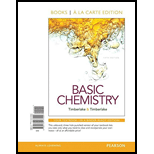
Concept explainers
(a)
Interpretation:
The total amount of heat needs to be calculated for the given system.
Concept Introduction:
The amount of heat involved in a process without changing the phase can be calculated as follows:
Here;
q is heat in J, m is mass of the substance in grams, C is specific heat in J/g °C and
If the phase is changing at certain temperature, the heat can be calculated as follows:
Here, ∆H = Enthalpy change due to change in phase.
(b)
Interpretation:
The total amount of heat needs to be calculated for the given system.
Concept Introduction:
The amount of heat involved in a process without changing the phase can be calculated as follows:
Here;
q is heat in J, m is mass of the substance in grams, C is specific heat in J/g °C and
If the phase is changing at certain temperature, the heat can be calculated as follows:
Here, ∆H = Enthalpy change due to change in phase.
(c)
Interpretation:
The total amount of heat needs to be calculated for the given system.
Concept Introduction:
The amount of heat involved in a process without changing the phase can be calculated as follows:
Here;
q is heat in J, m is mass of the substance in grams, C is specific heat in J/g °C and
If the phase is changing at certain temperature, the heat can be calculated as follows:
Here, ∆H = Enthalpy change due to change in phase.
(d)
Interpretation:
The total amount of heat needs to be calculated for the given system.
Concept Introduction:
The amount of heat involved in a process without changing the phase can be calculated as follows:
Here;
q is heat in J, m is mass of the substance in grams, C is specific heat in J/g °C and
If the phase is changing at certain temperature, the heat can be calculated as follows:
Here, ∆H = Enthalpy change due to change in phase.
Want to see the full answer?
Check out a sample textbook solution
Chapter 10 Solutions
Basic Chemistry, Books a la Carte Edition (5th Edition)
 ChemistryChemistryISBN:9781305957404Author:Steven S. Zumdahl, Susan A. Zumdahl, Donald J. DeCostePublisher:Cengage Learning
ChemistryChemistryISBN:9781305957404Author:Steven S. Zumdahl, Susan A. Zumdahl, Donald J. DeCostePublisher:Cengage Learning ChemistryChemistryISBN:9781259911156Author:Raymond Chang Dr., Jason Overby ProfessorPublisher:McGraw-Hill Education
ChemistryChemistryISBN:9781259911156Author:Raymond Chang Dr., Jason Overby ProfessorPublisher:McGraw-Hill Education Principles of Instrumental AnalysisChemistryISBN:9781305577213Author:Douglas A. Skoog, F. James Holler, Stanley R. CrouchPublisher:Cengage Learning
Principles of Instrumental AnalysisChemistryISBN:9781305577213Author:Douglas A. Skoog, F. James Holler, Stanley R. CrouchPublisher:Cengage Learning Organic ChemistryChemistryISBN:9780078021558Author:Janice Gorzynski Smith Dr.Publisher:McGraw-Hill Education
Organic ChemistryChemistryISBN:9780078021558Author:Janice Gorzynski Smith Dr.Publisher:McGraw-Hill Education Chemistry: Principles and ReactionsChemistryISBN:9781305079373Author:William L. Masterton, Cecile N. HurleyPublisher:Cengage Learning
Chemistry: Principles and ReactionsChemistryISBN:9781305079373Author:William L. Masterton, Cecile N. HurleyPublisher:Cengage Learning Elementary Principles of Chemical Processes, Bind...ChemistryISBN:9781118431221Author:Richard M. Felder, Ronald W. Rousseau, Lisa G. BullardPublisher:WILEY
Elementary Principles of Chemical Processes, Bind...ChemistryISBN:9781118431221Author:Richard M. Felder, Ronald W. Rousseau, Lisa G. BullardPublisher:WILEY





